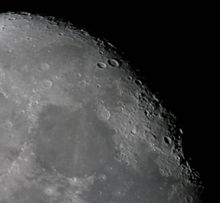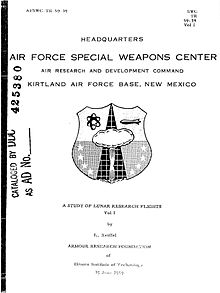- Project A119
-
Project A119, also known as "A Study of Lunar Research Flights", was a top-secret plan developed in the late 1950s by the United States Air Force. The aim of the project was to detonate a nuclear bomb on the Moon to boost public morale in the United States after the Soviet Union took an early lead in the Space Race. The existence of the project was revealed in 2000 by a former executive at the National Aeronautics and Space Administration (NASA), Leonard Reiffel, who led the project in 1958. A young Carl Sagan was part of the team responsible for predicting the effects of a nuclear explosion in low gravity.
Project A119 was never carried out, primarily because a moon landing would be a much more acceptable achievement in the eyes of the American public. The project documents remained secret for nearly 45 years, and despite Reiffel's revelations, the US government has never officially recognized his involvement in the study.
Contents
Background
During the Cold War, the Soviet Union took the lead in the Space Race with the launch of Sputnik 1 on October 4, 1957. Sputnik was the first artificial satellite in orbit around the Earth, and the surprise of its successful launch, compounded by the resounding failure of Project Vanguard to launch an American satellite after two attempts, has been dubbed the "Sputnik crisis" and was the impetus for the beginning of the Space Race. Trying to reclaim lost ground, the United States embarked on a series of new projects and studies, which eventually included the launch of Explorer 1 and the creation of the Defense Advanced Research Projects Agency (DARPA) and NASA.[1]
Project
In May 1958, the Armour Research Foundation, based at the Illinois Institute of Technology, began covertly researching the potential consequences of an atomic explosion on the Moon. The main objective of the program, which ran under the auspices of the United States Air Force, which had initially proposed it, was to cause a nuclear explosion that would be visible from Earth. It was hoped that such a display would boost the morale of the American people.[2]
At the time of the project's conception, newspapers were reporting a rumor that the Soviet Union was planning to detonate a hydrogen bomb on the Moon. According to press reports in late 1957, an anonymous source had divulged to a United States Secret Service agent that the Soviets planned to commemorate the anniversary of the October Revolution by causing a nuclear explosion on the Moon to coincide with an eclipse on November 7. News reports of the rumored launch included mention of targeting the dark side of the terminator—Project A119 would also consider this boundary as the target for an explosion. It was also reported that a failure to hit the Moon would likely result in the missile returning to Earth.[3]
A similar idea was put forward by Edward Teller, the "father of the H-bomb", who, in February 1957, proposed the detonation of atomic devices both on and some distance from the lunar surface to analyze the effects of the explosion.[4]
Research
 The explosion was intended to occur along the Moon's terminator, for maximum visibility from Earth.
The explosion was intended to occur along the Moon's terminator, for maximum visibility from Earth.
A ten-member team led by Leonard Reiffel was assembled at the Illinois Institute of Technology in Chicago to study the potential visibility of the explosion, benefits to science, and implications for the lunar surface. Among the members of the research team were astronomer Gerard Kuiper and his doctoral student Carl Sagan, who was responsible for the mathematical projection of the expansion of a dust cloud in space around the Moon, an essential element in determining its visibility from Earth.[2][4][5]
Scientists initially considered utilizing a hydrogen bomb for the project, but the United States Air Force vetoed this idea due to the weight of such a device, as it would be too heavy to be propelled by the missile which would have been used.[6] It was then decided to use a W25 warhead, a small, lightweight warhead with a relatively low 1.7 kiloton yield.[4] By contrast, the Little Boy bomb dropped on the Japanese city of Hiroshima in 1945 had a yield of some 13–18 kilotons.[7] The W25 would be carried by a rocket toward the unilluminated side of the Moon, near the terminator, where it would detonate on impact. The dust cloud resulting from the explosion would be lit by the Sun and therefore visible from Earth.[4][5] According to Reiffel, the Air Force's progress in the development of intercontinental ballistic missiles would have made such a launch feasible by 1959.[8]
Cancellation
The project was eventually canceled by the Air Force in January 1959, seemingly out of fear of a negative public reaction and the risk to the population should anything have gone wrong with the launch. Another factor, cited by project leader Leonard Reiffel, was the possible implications of the nuclear fallout for future lunar research projects and colonization.[8][6]
Later reports show that a corresponding Soviet project did indeed exist, but differed from the scenario reported in the press. Started in January 1958, it was part of a series of proposals under the codename "E". Project E-1 entailed plans to reach the Moon, while projects E-2 and E-3 involved sending a probe around the far side of the Moon to take a series of photographs of its surface. The final stage of the project, E-4, was to be a nuclear strike on the Moon as a display of force. As with the American plan, the E series of projects was canceled while still in its planning stages due to concerns regarding the safety and reliability of the launch vehicle.[9][10]
Consequences
The signing of the Partial Nuclear Test Ban Treaty in 1963 and the Outer Space Treaty in 1967 prevented future exploration of the concept of detonating a nuclear device on the Moon. However, by this time both the United States and the Soviet Union had performed several high-altitude nuclear explosions, including those of Operation Hardtack I, Operation Argus, Operation Dominic I and II, and The K Project.[4]
Project A119 came to light due to research carried out for a biography of Carl Sagan.
By 1969, the United States had achieved a considerable victory in the Space Race after the success of the Apollo 11 mission.[11] In December that year, Apollo scientist Gary Latham suggested detonating a "smallish" nuclear device on the Moon in order to facilitate research into its geologic make-up.[12] The idea was dismissed, however, as it would interfere with plans to measure the Moon's natural background radiation.[13]
The existence of Project A119 remained largely secret until the mid-1990s, when writer Keay Davidson discovered the story while researching the life of Carl Sagan for a biography. Sagan's involvement with the project was apparent from his application for an academic scholarship at the University of California, Berkeley's Miller Institute in 1959. In the application, Sagan gave details of the project research, which Davidson felt constituted a violation of national security.[14] The leak consisted of Sagan revealing the titles of two classified papers from the A119 project—the 1958 paper Possible Contribution of Lunar Nuclear Weapons Detonations to the Solution of Some Problems in Planetary Astronomy, and the 1959 paper Radiological Contamination of the Moon by Nuclear Weapons Detonations.[15] These were among the eight reports created by the project, all of which were destroyed in 1987.[2]
The resulting biography—Carl Sagan: A Life—was published in 1999. Shortly after, a review published in Nature highlighted the discovery of the leaked information.[16] This led Dr. Reiffel to break his anonymity and write a letter to the journal confirming that Sagan's activity had at the time been considered a breach in the confidentiality of the project. Reiffel took the opportunity to reveal details of the studies, and his statements would later be widely reported in the media.[5][17] Reiffel's public admission of the project was accompanied by his denouncement of the work carried out, with the scientist noting that he was "horrified that such a gesture to sway public opinion was ever considered".[2]
As a result of the publicity the correspondence created, a freedom of information request was lodged concerning Project A119. It was only then that A Study of Lunar Research Flights – Volume I was made public, over forty years after its inception.[18] A search for the other volumes of documentation, however, revealed that other reports were destroyed in the 1980s by the Illinois Institute of Technology.[4]
Dr. David Lowry, a British nuclear historian, has called the project's proposals "obscene", adding "had they gone ahead, we would never have had the romantic image of Neil Armstrong taking "one giant leap for mankind"."[2]
References
- ^ "50th Anniversary of the Space Age". NASA. http://www.nasa.gov/externalflash/SpaceAge/index.html. Retrieved September 8, 2011.
- ^ a b c d e Barnett, Antony (May 14, 2000). "US planned one big nuclear blast for mankind". The Guardian. http://www.guardian.co.uk/science/2000/may/14/spaceexploration.theobserver. Retrieved September 8, 2011.
- ^ Myler, Joseph L (November 1, 1957). "Latest Red Rumor: They'll Bomb Moon". Pittsburgh Press: p. 13. http://news.google.com/newspapers?id=5kUqAAAAIBAJ&sjid=Bk4EAAAAIBAJ&pg=5584,131807. Retrieved September 9, 2011.
- ^ a b c d e f Ulivi, Paolo; Harland, David Michael; Zhou, Chaochen (2004). Lunar Exploration: Human Pioneers and Robotic Surveyors. Springer. pp. 19–21. ISBN 185233746X. http://books.google.com/books?id=W1f4TvNUwLsC.
- ^ a b c Broad, William J (May 16, 2000). "U.S. Planned Nuclear Blast On the Moon, Physicist Says". The New York Times. http://select.nytimes.com/gst/abstract.html?res=F10716FD3A5F0C758DDDAC0894D8404482. Retrieved September 9, 2011.
- ^ a b Associated Press (May 18, 2000). "U.S. Weighed A-Blast on Moon in 1950s". Los Angeles Times. http://articles.latimes.com/2000/may/18/news/mn-31395. Retrieved September 9, 2011.
- ^ Hoddeson, Lillian; Henriksen, Paul W.; Meade, Roger A.; Westfall, Catherine L. (1993). Critical Assembly: A Technical History of Los Alamos During the Oppenheimer Years, 1943–1945. Cambridge University Press. pp. 392–393. ISBN 0521541174. OCLC 26764320.
- ^ a b Associated Press (May 18, 2000). "U.S. considered lunar a-bomb blast". Pittsburgh Post-Gazette: p. 7. http://news.google.com/newspapers?id=_IcNAAAAIBAJ&sjid=rW8DAAAAIBAJ&pg=6998,5299680. Retrieved September 9, 2011.
- ^ Zheleznyakov, Aleksandr. "The original E-3 project – exploding a nuclear bomb on the Moon". Sven Grahn. http://www.svengrahn.pp.se/histind/E3/E3orig.htm. Retrieved September 9, 2011.
- ^ Tanner, Adam (July 9, 1999). "Russia wanted nuclear bomb on moon". Independent Online. http://www.iol.co.za/news/world/russia-wanted-nuclear-bomb-on-moon-1.4078. Retrieved September 9, 2011.
- ^ Angelo, Joseph A (2007). Human Spaceflight (illustrated ed.). Infobase Publishing. p. 28. ISBN 0816057753.
- ^ "Moon madness". The Sydney Morning Herald: p. 19. December 21, 1969. http://news.google.com/newspapers?id=ZJApAAAAIBAJ&sjid=5-cDAAAAIBAJ&pg=5506,6803546. Retrieved September 9, 2011.
- ^ "Scientist Withdraws Plans for Nuclear Blast on Moon". St. Petersburg Times: p. 7. January 7, 1970. http://news.google.com/newspapers?id=ZQIOAAAAIBAJ&sjid=1nsDAAAAIBAJ&pg=5751,4416523. Retrieved September 9, 2011.
- ^ Davidson, Keay; Sagan, Carl (1999). Carl Sagan: A Life. Wiley. p. 95. ISBN 0471252867. http://books.google.com/books?id=TXDvAAAAMAAJ.
- ^ Dörries, Matthias (2011). "The Politics of Atmospheric Sciences: “Nuclear Winter” and Global Climate Change". Osiris (University of Chicago Press, on behalf of The History of Science Society) 26 (1): 198–223. doi:10.1086/661272. JSTOR 661272.
- ^ Chyba, Christopher (October 28, 1999). "An exobiologist's life search". Nature 401 (6756): 857–858. doi:10.1038/44716. http://www.nature.com/nature/journal/v401/n6756/full/401857a0.html. Retrieved September 9, 2011.
- ^ Reiffel, Leonard (May 4, 2000). "Sagan breached security by revealing US work on a lunar bomb project". Nature 405 (6782): 13. doi:10.1038/35011148. http://www.nature.com/nature/journal/v405/n6782/full/405013a0.html. Retrieved September 9, 2011.
- ^ "A Study of Lunar Research Flights, Volume I". Defense Technical Information Center. http://oai.dtic.mil/oai/oai?verb=getRecord&metadataPrefix=html&identifier=AD0425380. Retrieved September 9, 2011.
Categories:- Cold War history of the United States
- Exploration of the Moon
- Nuclear weapons program of the United States
- Secret military programs
Wikimedia Foundation. 2010.


